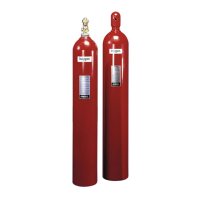SECTION III
UL EX-4510 12-1-01 Page 3-1
INERGEN
® AGENT
INERGEN is a plentiful, non-corrosive gas that does not
support combustion nor react with most substances.
INERGEN agent contains only naturally-occurring gases
which have no impact on the ozone or the environment in
general. INERGEN agent is a mixture of three inerting (oxy-
gen diluting) gases: 52% nitrogen, 40% argon, and 8% car-
bon dioxide (see MSDS in Section II). INERGEN extin-
guishes fire by lowering the oxygen content below the level
that supports combustion. When INERGEN agent is dis-
charged into a room, it introduces the proper mixture of
gases that allow a person to breathe in a reduced oxygen
atmosphere. It actually enhances the body’s ability to accu-
mulate oxygen. The normal atmosphere in a room contains
approximately 21% oxygen and less than 1% carbon diox-
ide. If the oxygen content is reduced below 15%, most ordi-
nary combustibles will not burn. INERGEN agent will
reduce the oxygen content to approximately 12.5% while
increasing the carbon dioxide content to about approxi-
mately 3%. The increase in the carbon dioxide content
increases a person’s respiration rate and the body’s ability
to absorb oxygen. Simply stated, the human body is stimu-
lated by the carbon dioxide to breathe more deeply and
rapidly to compensate for the lower oxygen content of the
atmosphere.
PERSONAL SAFETY
Proper INERGEN system design requires that the design
concentrations fall within a design window that limits the
upper and lower requirements of both oxygen and carbon
dioxide. INERGEN agent has acceptable toxicity for use in
occupied spaces when used as specified in the United
States Environmental Protection Agency (EPA) proposed
Significant New Alternative Policy (SNAP) program rules
and NFPA 2001, “Clean Agent Fire Extinguishing Systems.”
When design concentrations are in this window, no adverse
affects will take place on the human respiratory system.
Any exposure outside of these limits requires the use of
self-contained breathing apparatus. Respirators will not
function in oxygen deficient atmospheres. Because of the
decomposed products of combustion generated during an
actual fire and extinguishment, it is a good safety rule to
ventilate the hazard for at least 15 minutes before entering
or if entry is required sooner, wear an approved self-con-
tained breathing apparatus.
Refer to NFPA 2001, 2000 edition, Paragraph 1-6.1.3, “Inert
Gas Clean Agents,” for detailed exposure conditions.
HMIS 1-0-0/very cold discharge. Contents under high
pressure.
Avoid direct contact of the cold, high pressure discharge
and avoid direct inhalation of undiluted gas.
WARNING
AVOID EXPOSURE TO VAPORS, FUMES,
AND PRODUCTS OF COMBUSTION.
TYPE OF SYSTEM
Total flooding is the approved type of system available. A
total flooding system normally consists of a fixed supply of
INERGEN connected to piping with nozzles to direct the
agent into an enclosed hazard space. In a total flooding
system, the enclosure around the hazard must be tight
enough to hold the required percentage of INERGEN con-
centration for a period of time to extinguish the fire.
TYPES OF ACTUATION
There are three basic types of actuation for the INERGEN
systems: pneumatic, mechanical, and electrical.
Electrical
Automatic electrical actuation of the cylinder valve,
through an approved control panel, can be accomplished
by using an HF actuator for the CV-98 valve. The actuator
is energized by an electric signal from the detection/control
panel. When using the electric actuator, pneumatic or
mechanical actuating devices can also be attached as a
secondary means of actuation. When using electric actua-
tion, a means of manual release shall also be provided.
Mechanical
Mechanical actuation is accomplished by a lever actuator
mounted on top of the cylinder valve or other actuators. By
rotating the lever on the actuator, either locally or from a
remote pull station, the cylinder valve can be opened,
allowing the INERGEN to discharge through the piping and
nozzles.
General Information
ANSUL
®

